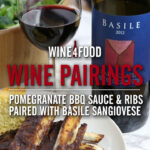
Italian wine has a well-defined hierarchy. Barbera and Nebbiolo rule Piemonte, while Prosecco-bound Glera and Pinot Grigio are the stars in the northeast. And then there’s Tuscany’s Sangiovese. The grape and its clones are behind numerous deep-red wines from the luxurious Brunello di Montalcino to your common Chianti.
Savory Sangiovese is Italy’s most widely planted red grape. Though most of its famous wines are made in Tuscany, plantings can be found throughout central and southern Italy. The grape is exceptional for displaying terroir, but all of its wines have cherry notes, rich tannins, and high acidity. Those tannins (the bitter, drying element of wine) make Sangiovese capable of being aged. Many of its high-end wines will spend at least one to two years in barrels.

Chianti
You know it. You may love it. It goes really well with pizza. Wines from Tuscany’s Chianti DOCG (Denominazione di Origine Controllata e Garantita) must be at least 70% Sangiovese, and display those famous flavors of red fruit with balsamic and herbal notes. The famous Chianti subzones to seek out are Colli Fiorentini, Colli Senesi, and Rufina. It’s easy to find a good Chianti for around $20.
TRY: Castel di Pugna Ellera Chianti Colli Senesi, Marchesi dé Frescobaldi Nipozzano Riserva Chianti Rufina, and Selvapiana Chianti Rufina
Chianti Classico
In the middle of the Chianti DOCG is a separate territory for growing Chianti Classico DOCG. This is the historically accurate home of Chianti, and is now the more prestigious of the two DOCGs. Chianti Classico requires wines to be at least 80% Sangiovese and aged at least one year in order to earn their black rooster seal. If you want to taste the cream of the Chianti crop, look for Chianti Classico Gran Selezione. That’s when all the grapes are grown together and aged for at least two-and-a-half years. Chianti Classicos are commonly $30 – $40.
TRY: Marchese Antinori Chianti Classico Riserva, Querciabella Chianti Classico, and Castello di Volpaia Chianti Classico
Brunello di Montalcino
In the southern part of Tuscany, within Chianti’s Colli Senesi area, lies the centuries-old town of Montalcino. In the late 1800s, Ferruccio Biondi-Santi decided to propagate his finest Sangiovese vines for “science.” The descendants of those vines are now grown around Montalcino and make some of Italy’s finest wines. The upper-tier is Brunello di Montalcino, which must be 100% Sangiovese, aged at least two years in a barrel, and then spends two-three years in the bottle. This longer aging is why bottles of Brunello regularly cost over $50, and can reach the high hundreds. Since producers reserve their best grapes for Brunello, and wait so long for it, they also produce other wines from other vines. One of these styles is Rosso di Montalcino, another 100% Sangiovese wine that only needs to be aged for one year. These are often found for $25 or less.
TRY: Conti Costanti, Fattoria dei Barbi, and Biondi Santi (all make both)
Other Sangiovese Styles
Of course, these four aren’t the only wines for Sangiovese. There is Vino Nobile di Montepulciano, which many sommeliers think is vastly overlooked. Also in Tuscany is Montecucco, a newer Italian DOC region that neighbors the famous Montalcino area. Or you can go out of Tuscany altogether and pick up a bottle from elsewhere in Central Italy.
TRY: Il Macchione Vino Nobile, Basile Cartacanta Montecucco DOC, and Castello delle Regine Poggio delle Regine Rosso
Food Pairing
Italian wines are often best paired with Italian food. Sangiovese is no different. These wines are the perfect accompaniment to tomato-based pasta dishes and all kinds of pizza. The acidity and tannins also play well with rich cured meats, roasted chicken, meaty mushrooms, and steak. In fact, many Italians believe that Sangiovese pairs better with steak than Cabernet Sauvignon.


